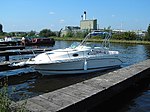Rawcliffe, East Riding of Yorkshire
Civil parishes in the East Riding of YorkshireEast Riding of Yorkshire geography stubsLocal Nature Reserves in the East Riding of YorkshireUse British English from June 2015Villages in the East Riding of Yorkshire

Rawcliffe (or Rawcliffe in Snaith) is a village and civil parish in the East Riding of Yorkshire, England on the border with North Yorkshire. It is situated approximately 4 miles (6.4 km) west of Goole and 17 miles (27 km) south of York. It lies on the banks of the River Aire just north of the M62 and on the A614 road. Rawcliffe, along with nearby Airmyn, was the location of one of the first reliable reports of the practice of warping in agriculture in the 1730s.
Excerpt from the Wikipedia article Rawcliffe, East Riding of Yorkshire (License: CC BY-SA 3.0, Authors, Images).Rawcliffe, East Riding of Yorkshire
Chapel Lane,
Geographical coordinates (GPS) Address Nearby Places Show on map
Geographical coordinates (GPS)
| Latitude | Longitude |
|---|---|
| N 53.699718 ° | E -0.965053 ° |
Address
Chapel Lane
Chapel Lane
DN14 8QN , Rawcliffe
England, United Kingdom
Open on Google Maps










